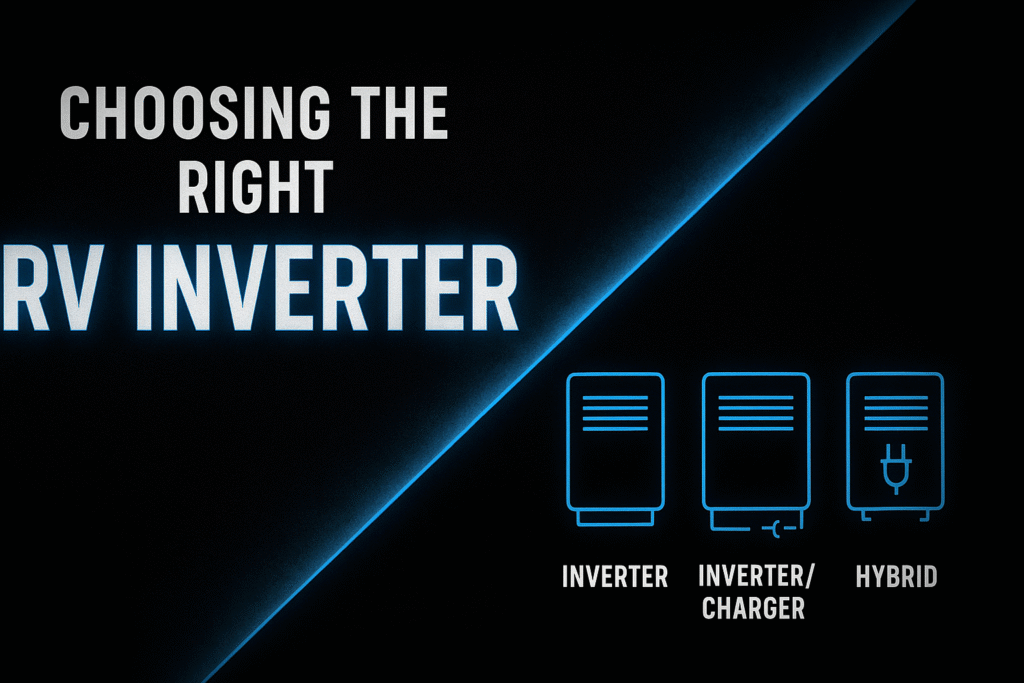RV Inverters How to Choose the Right Brand, Size, and Features
If you’ve ever stood in the aisle (or scrolled online) wondering why RV inverters cost $199 at one place and at another $1,499—this guide is for you. We’ll cut through marketing jargon and help you choose an RV inverter that matches your rig, your batteries, and the way you camp. No fluff—just a clear plan to get reliable 120-volt power off-grid.
What RV Inverters Actually Do
An inverter turns battery DC power (12/24V) into household AC power (120V) so you can run outlets and appliances when disconnected from shore power or the generator. Many modern units are inverter/chargers, which also recharge the batteries from shore/gen and manage transfer switching. Some “hybrid” models can blend inverter power with limited shore/generator power so you can briefly run bigger loads without tripping breakers.
The Big Types (Know These First)
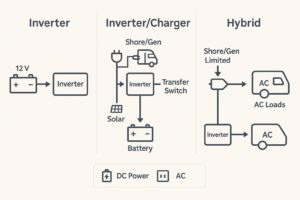 Modified Sine Wave (MSW): Cheaper, less efficient, and can make sensitive gear buzz or overheat. OK for simple loads (resistive heaters, basic tools), but not recommended for today’s electronics.
Modified Sine Wave (MSW): Cheaper, less efficient, and can make sensitive gear buzz or overheat. OK for simple loads (resistive heaters, basic tools), but not recommended for today’s electronics.- Pure Sine Wave (PSW): Clean utility-like power for laptops, TVs, CPAPs, induction cooktops, microwaves, and residential fridges. This is what most RVers want.
- Inverter Only vs. Inverter/Charger: If you boondock or move often, an inverter/charger simplifies wiring and charging. If you already have a good charger or lithium-ready converter, an inverter-only may be fine.
- Hybrid Inverter/Charger: Adds power-assist—great for 30A rigs running short bursts of high loads (microwave + coffee maker) on marginal shore power.
Brand Landscape—How to Read Past the Logos
Plenty of reputable brands of RV Inverters exist. What really separates them are: waveform quality, surge capability, efficiency (idle and full-load), charger sophistication, programmability, ecosystem (monitors/BMS integration), and support/warranty. Here’s a simple way to compare—without starting a brand war:
- Power Class & Quality Tier
- Premium PSW / Hybrid (feature-rich, excellent power quality, deep programmability, strong ecosystems)
- Mid-range PSW (solid performance, fewer bells/whistles)
- Budget PSW (fine for light, occasional use; verify idle draw and protection features)
- MSW (only if you truly know your loads are tolerant)
- Ecosystem Fit
- Do you want one vendor for inverter, charger, solar controller, shunt/monitor, and app? Premium ecosystems make configuration and troubleshooting easier—and can protect expensive lithium batteries with better charge profiles.
- Support & Documentation
- Ask two questions: How quickly do they respond? and Can I get wiring diagrams, firmware notes, and phone support? A slightly pricier unit from a brand that actually helps you is often cheaper in the long run.
- Warranty & Installer Network
- Look for at least 2–5 years on mainstream rigs; check if warranty support requires purchase from authorized dealers or pro install.
Tip: When two models look identical on paper, compare idle consumption, surge duration (not just peak), low-temperature charging logic for lithium, and app/monitor options. Those details determine day-to-day happiness.
Sizing: The 10-Minute Load-Match Plan
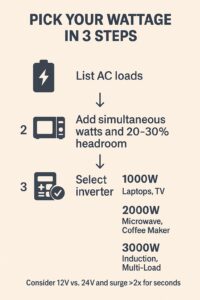 List the AC loads you actually use off-grid (not everything you own):
List the AC loads you actually use off-grid (not everything you own):
- “Must run”: CPAP, outlets for laptop/TV, Starlink, microwave, coffee maker, blender, induction cooktop, hair dryer, residential fridge.
- Starting vs. running watts: Motors and compressors (A/Cs, some fridges) need extra surge to start.
- Pick your biggest simultaneous loads and add them:
- Example: Microwave (1,200W running, 1,800W surge) + Coffee Maker (900W) + Misc outlets (200W) ≈ 2,300W running.
- Choose an inverter that covers continuous draw with headroom (20–30%) and has surge specs to match.
- Common Sizes
- 1,000–1,200W: Laptops, TV, chargers, small tools—no microwave.
- 2,000–2,200W: Most boondockers who want microwave/coffee maker.
- 3,000W: Heavy concurrent use, some induction cooking, multi-appliance bursts, power-assist hybrids.
- Battery Voltage & Capacity
- 12V systems are most common in RVs; large loads may benefit from 24V to cut current and cable size (requires compatible chargers/BMS).
- Ensure your battery bank (Ah) can support the inverter. A 2,000W inverter at 12V can draw ~170A under load; you’ll want adequate wiring, fusing, and batteries to handle that safely.
- Runtime Reality Check
- Multiply battery usable Wh by inverter+load efficiency. Example: 400Ah LiFePO₄ @ 12V ≈ ~5,120 Wh usable. Microwave for 10 minutes (1,200W) consumes ~200Wh; induction cooking at 1,500W for 30 minutes ≈ 750Wh. It adds up quickly—plan accordingly.
Features That Actually Matter (and Why)
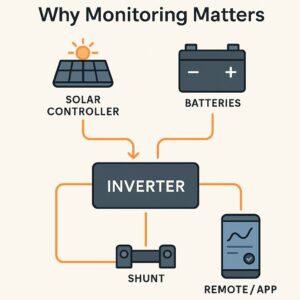 Pure Sine Output: Protects sensitive electronics; runs motors cooler and quieter.
Pure Sine Output: Protects sensitive electronics; runs motors cooler and quieter.- Surge Capability & Duration: Real life includes compressor starts and heating elements cycling. Look for 2× surge for several seconds.
- Charger Profiles (if inverter/charger): Lithium-specific charging with adjustable bulk/absorption/float and temp compensation avoids early battery aging.
- Hybrid/Power-Assist: If you’re frequently on 30A hookups, hybrids let you use short bursts of higher power by blending battery power with shore/gen—fewer breaker trips.
- Transfer Switch Speed: Fast switching reduces flicker when moving between shore, generator, and inverter.
- Idle Consumption & Search Mode: Lower idle means longer battery life when you leave the inverter on. Search/eco modes wake the inverter only when a load appears.
- Monitoring & App Control: A remote display or app (Bluetooth/Wi-Fi) is worth it for state of charge, load graphs, and fast troubleshooting.
- Protection Suite: Over/under-voltage, over-temp, short-circuit, overload, GFCI outlets (as required), and proper neutral/ground bonding logic with transfer switching.
Safety note: Follow the manufacturer’s wiring instructions, proper fusing, and relevant standards (e.g., NEC/ABYC). If in doubt, use a pro.
Decision Flow: Which Kind Do You Need?
- Weekend Hookups, Light Off-Grid:
Pure sine 1,000–1,200W inverter (or small inverter/charger). Prioritize low idle draw and a simple remote. - Frequent Boondocking, Microwave/Work Devices:
Pure sine 2,000–2,200W inverter/charger with lithium-ready profiles, remote display/app, and good surge. - Full-Time or “Small House” Loads, 30A Rig:
3,000W hybrid inverter/charger with power-assist, plus robust monitoring. Consider 24V battery if you’re building a large system. - Generator-Assist Strategy:
Hybrids shine: set input limits (e.g., 15A) and let the inverter blend battery power when loads spike.
Install & Integration Tips (Save Yourself Headaches)
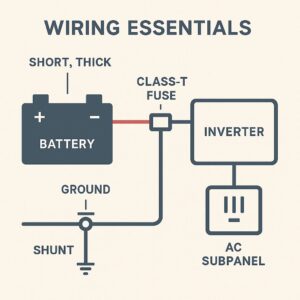 Place the inverter close to the batteries to minimize voltage drop; use proper cable gauge and Class-T fusing per the manual.
Place the inverter close to the batteries to minimize voltage drop; use proper cable gauge and Class-T fusing per the manual.- Keep DC cable runs short; AC wiring can be longer if needed.
- If adding to an existing RV converter/charger, decide which device will handle charging to avoid conflicts (many replace the converter entirely with an inverter/charger).
- Add a master disconnect and label everything—future you (or your tech) will thank you.
- Pair with a shunt-based battery monitor to know exact in/out amps and state of charge.
Quick Brand-Neutral Cheat Sheet
- Best for sensitive electronics: Pure Sine Wave always.
- Best for 30A rigs with high bursts: Hybrid Inverter/Charger with power-assist.
- Best for budget/light use: Smaller PSW inverter with low idle draw.
Best for integrated systems: Choose a brand with a strong ecosystem (inverter, charger, solar, BMS, monitor, and app that “talk” to each other).
Do I really need Pure Sine Wave?
If you power laptops, CPAPs, TVs, a microwave, induction, or a residential fridge—yes. MSW can make motors run hot and electronics glitch.
What size inverter should I buy?
Add up simultaneous loads and choose a unit with 20–30% headroom. Most boondockers land on 2,000–2,200W; heavy users or hybrid setups often choose 3,000W.
Can my batteries handle a 2,000–3,000W inverter?
Check continuous current. A 2,000W inverter at 12V can draw ~170A. Ensure your battery bank, cabling, fusing, and BMS support it—this is why many large builds choose 24V.
What’s the difference between an inverter and an inverter/charger?
Inverter/chargers add onboard charging and a transfer switch, simplifying wiring and giving you proper profiles for AGM/LiFePO₄.
What is a hybrid inverter?
It can blend shore/gen power with battery power to cover short, high-demand bursts—fantastic on 30A hookups.
Will an inverter run my air conditioner?
Technically possible, but rarely practical on 12V without a large lithium bank, soft-start, and robust charging. Many RVers stick to short A/C runs on generator or shore power.
How important is idle draw?
Very. If you leave the inverter on, a low idle watt or search mode can save hundreds of Wh per day—huge for boondocking.
Can I install it myself?
Many do, but mistakes are expensive. If you’re unfamiliar with neutral/ground bonding, transfer switching, or fusing, hire a pro.
